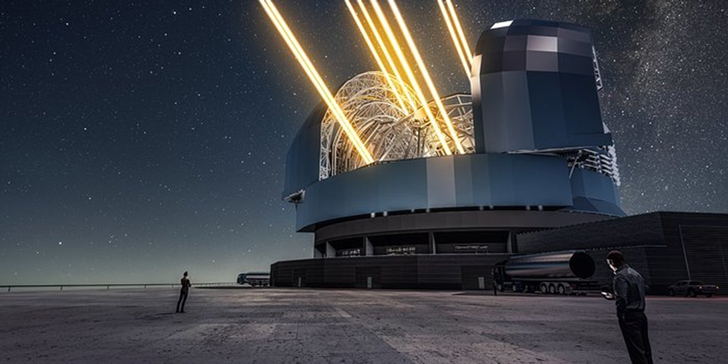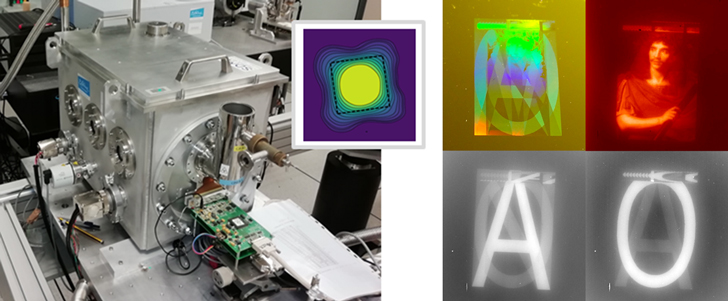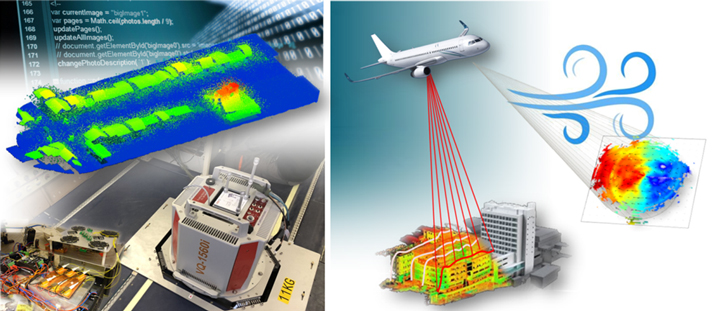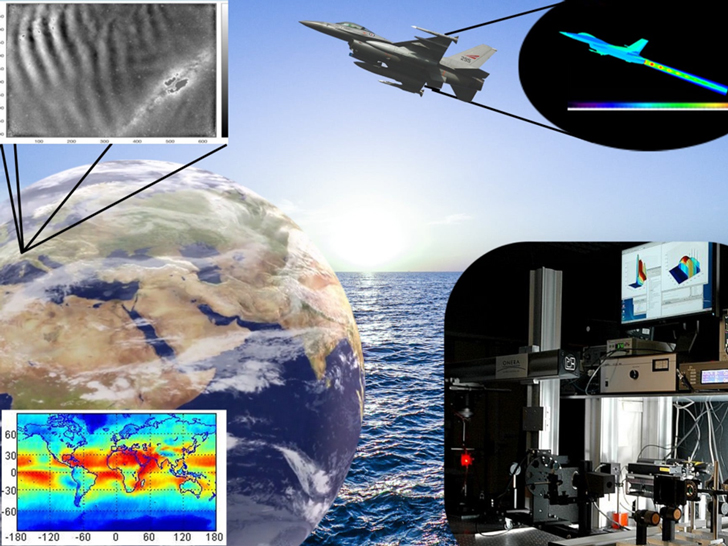- ONERA
- Scientific Departments
- DOTA - Optics and Associated Techniques
- Scientific topics
DOTA - Scientific topics
Active and passive remote sensing
This theme aims to better understand the optronics scene in order to meet needs related to Defense (ONERA DOTA is labelled as optronic environment referent for DGA programs) but also to Security and Environment. Work is focused on improving environmental knowledge in the Earth-Atmosphere system by remote sensing from land, airborne or space. Different means (experimental or simulation) and data exploitation methods are used to evaluate the contribution of new remote sensing technologies such as high spatial and/or spectral resolution passive imaging over the entire optical domain (0.4-12 µm), or active imaging, as well as their complementarity. Such an approach involves identifying and evaluating characteristic variables of the geometric/bio-physical-chemical properties of the scene elements. The estimation of these variables is a real challenge because it must be carried out with controlled uncertainties.
The “Active and passive remote sensing” theme involves the POS, IODI, ERIO, MOTA, MVA and MPSO units.
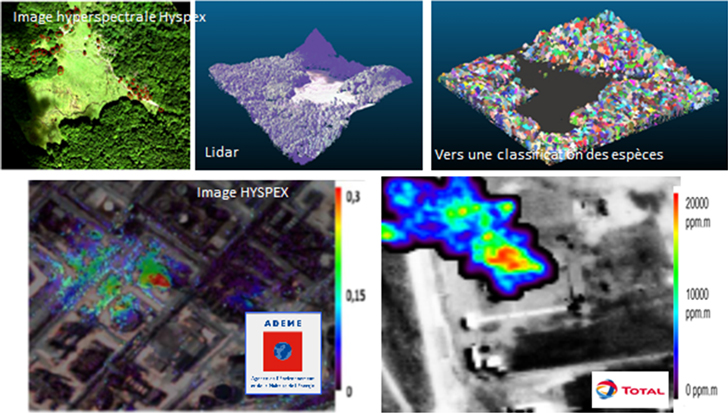
Top: Merging of a hyperspectral image and a telemetric lidar image for the determination of forest tops in mountainous areas. Bottom: Anthropogenic air pollution (monitoring of intense aerosol sources and gas emission concentration map)
Adaptive optics, Wave Front Measurement and Control
This theme is at the heart of high-resolution angular imaging and focusing of laser beams. It has for direct application the observation of space (on the largest ground-based or space telescopes), earth observation, free space telecommunications, endo-atmospheric imaging, laser weapon, biomedical imaging or laser surgery. These activities, for the most part dual, are based on:
- A detailed knowledge of the physical environments and phenomena disturbing the propagation of the electromagnetic wave,
- The control of the propagation channel (in coherent or incoherent light),
- The proposal of innovative concepts for measuring the wavefront or the complex field under extreme conditions (low signal-to-noise ratio, complex objects, extreme environments ...)
- The development of control laws allowing real-time correction
- The implementation of a post processing technics that make the best use of the knowledge of the environment and observed phenomena.
This theme spans a large TRL range from the proposal of new ideas to the realization of demonstrators and the final implementation of fully operational instruments.
The Wave Surface Control/Adaptive Optics theme mainly involves the HRA unit but also the CIO and MOTA units.
The European Extremely Large Telescope (ELT) is a ground-based telescope, part of the suit of three giant telescopes under construction. With a 39m diameter, beyond state-of-the-art technologies and instrumentations, ELT will be, in mid-2020, the most complex and most powerful observatory ever built. At the heart of the ELT's Adaptive Optics, ONERA imagines and designs the systems and components that will make it possible to overcome the harmful effects of atmospheric turbulence and deliver an image quality hitherto unsurpassed (10 milli- arc seconds, or 50 nano-radians) and this for almost all the observable sky
Optoelectronics: photodetection and nanophotonics
The "Optoelectronics: Photodetection and Nanophotonics" theme aims to study the interaction of light and matter for the wavelength ranges from visible and near infrared to terahertz.
The "Physics of Photodetection" research axis is devoted to the experimental study and modelling of the photodetection process, historically in the infrared domain (from 0.8 to 20 μm) and recently in the low-light level visible domain. Our approach consists in considering the photodetector as an object of study and expertise. This activity is carried out in collaboration with academic and industrial actors in the field, and on behalf of the DGA. This activity is based on a fleet of equipment and test protocols that have been made reliable and serve as a reference (MTF measurement, spectral response measurement, noise measurement, etc.) and whose development is ongoing.
The "Nanophotonics" research axis consists in studying from a theoretical and experimental point of view micro-optical devices applied as close as possible to the detectors, with the aim of improving the embedability of infrared detectors (reduction of space requirements, reduction of the cost related to cryogenics, etc.), accessing new optical functions, and improving the performance of existing detectors. Our approach aims to understand the fundamental properties of subwavelength structures from the development of a technological manufacturing process and a validation phase of behavioural models to their implementation in a practical application (in the laboratory or in the field).
The Optoelectronics: photodetection and nanophotonics theme involves the CIO, ERIO and MOTA units.
Left: MIRCOS MTF measuring bench and example of a pixel profile (black dotted line: theoretical pixel profile); right: picture of a metasurface in the visible domain and associated thermal emission obtained for different polarisations and wavelengths
Fibre lasers, lidars and 3D imagers
The scientific activities of this theme are the design, development and performance evaluation of laser sources, lidar instruments and laser imagers for various application areas such as defense, security and environment.
Different types of laser systems are studied: high-power lasers, lidars for velocity or vibration measurement, lidars for the measurement and characterization of gases or aerosols and finally 2D or 3D laser imagers. These achievements require mastery of the complete system from laser source to signal processing, including architecture, detection and acquisition.
The research main lines for future systems are:
- Design high-performance laser sources: development of sources at new wavelengths, power-up and laser combining techniques
- Increase instrument performance: range, spectral coverage, resolution, measurement availability, real-time measurement
- Improve integration, embeddability and robustness in hostile environments (aeronautical, spaceborne applications ...)
- Develop new features, multi-function capabilities and address new applications
- Exploit technological breakthroughs in components and mature innovative laboratory concepts to field instruments
The Fiber lasers / lidars and 3D Imagers theme involves the SLS, IODI and MOTA units.
Development of aircraft embedded lidar instruments for 3D mapping of scenes and measurement of wind fields
Optical sensors and hyperspectral imagers
The « optical devices and hyperspectral imagery » theme aims at developing opto-electronical devices to fulfill the following goals:
- Undertake our assignments of optronic environment referent for DGA programs;
- Deploy optical devices to the field, either at ground level or as airborne payloads;
- Predict future breakthroughs in the field of opto-electronical devices;
- Design new tools to analyze, design and assess performance of opto-electronical devices.
This research field currently centers on three thematic focuses:
- Development of optical devices for physical measures and for intelligence. It aims at improving the knowledge of optical scenes and measuring target signatures. Additionally unique on the market radiometers, spectrometers, hyperspectral and multispectral devices are designed and made.
- Frugal approach for designing opto-electronical devices: it aims at implementing an imagery function or at designing an optical architecture in the simplest way while answering to compelling specifications such as volume or cost. To succeed, breakthrough technologies are studied like lenslet arrays, diffractive optics, cryogenic optics, freeform optics, gradient index optics… The operational gains of these new devices are then compared to the existing.
- And most recently, new optimization algorithms for optical devices. It aims at developing new design rules by taking advantages of the current mathematical achievements to deal with complex designs involving many degrees of freedom in a global optimization strategy that takes into account their manufacturability and their interaction with further image processing.
The theme of optical sensors and hyperspectral imagers mainly involves the ERIO and CIO units, as well as the HRA, MOTA and MPSO units.
 Development and operation of an airborne infrared hyperspectral system, B) integration of a cryogenic infrared camera inside a UAV payload, C) cryogenic infrared cam-on-chip
Development and operation of an airborne infrared hyperspectral system, B) integration of a cryogenic infrared camera inside a UAV payload, C) cryogenic infrared cam-on-chip
Environment and signatures for optronic sensors
The activities under the “Environment and signatures for optronic sensors” theme focus on the provision of experimental and simulated radiative data for the evaluation of the performance of optronic sensors in the specification and design phase, during acceptance and during their operational use. They cover theoretical aspects, development and implementation of simulations such as the radiative transfer code MATISSE, acquisition and exploitation of experimental data for the validation and completion of models and the capitalisation in reference databases, in particular the MEMOIRES thermo-optical properties database. The role of optronic environment referent for DGA programs is structuring for all these activities, which concern:
- The study of optical radiation sources, of natural and artificial origin, which constitute the background signal observed by a passive or active optical sensor designed to acquire the signal of an object of interest, as well as phenomena likely to influence the propagation of radiation from the source to the sensor,
- The modelling of the background clutter (land, clouds, sea, atmosphere) with a sufficient level of realism so that the synthetic scenes can be used in addition to experimental data to evaluate the performance of an optronics sensor,
- The experimental study and detailed modelling of optical signatures of targets of military interest such as aircrafts, tactical and ballistic missiles and satellites.
- The statistical evaluation of signatures, the study of climatologies and their impact on signature dispersion,
- The development of methodologies that allow to assess the level of realism/physical representativeness of visible color synthetic image generator and to predict soldier-in-the-loop target acquisition performances (DRI ranges) of visible imaging systems.
The Environment and Signatures for optronic sensors theme involves the MPSO, MVA, IODI, ERIO, HRA, MOTA and CIO units.
Overview of the activities with a focus on: nightglow radiation measurement - aircraft signature simulations with CRIRA - aerosols climatologies - measurement of optical properties of materials at MELOPEE lab

